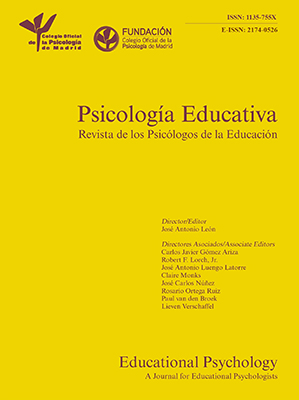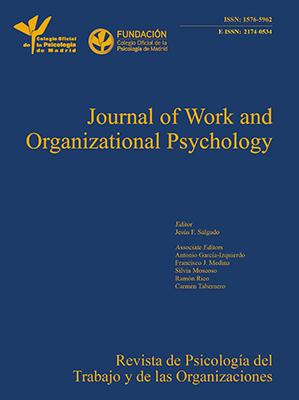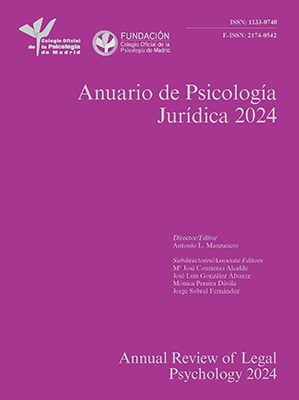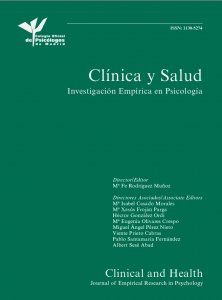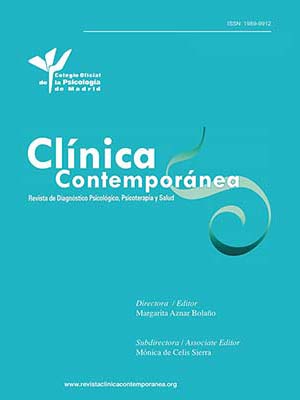
Interpersonal Risk and Protective Factors for Adolescents’ Psychosocial Wellbeing in Secondary Education: A Latent Profile Analysis
Rocío Herrero Romero1, Kevin van der Meulen1, Laura Granizo1, Cristina del Barrio1, Pablo Puyol1, Laura Lara2, and Ricardo Olmos1
1Universidad AutĂłnoma de Madrid, Spain; 2Universidad de Sevilla, Spain
https://doi.org/10.5093/pi2025a10
Received 18 October 2024, Accepted 12 April 2025
Abstract
Objective: The concept of adolescent wellbeing has emerged as an essential component of adolescent health, occupying a pivotal position within public and policy agendas. While researchers agree that psychosocial wellbeing is a multidimensional construct comprising objective and subjective elements, many studies focus on a single domain or context of wellbeing. This study (1) identifies different profiles of adolescent psychosocial wellbeing (including psychological and educational domains) and (2) examines how interpersonal risk and protective factors across different ecological contexts relate to these profiles. Method: Latent profile analysis (LPA) and posterior multinomial logistic regressions were conducted on a community sample of 1,627 adolescents aged 11 to 23 in secondary education in the Madrid region. Results: Three distinct profiles emerged. Adolescents in the Behaviourally Challenging Profile (8%), with a particularly high prevalence of conduct problems, showed poor psychological and educational adjustment; adolescents in the Emotionally Struggling Profile (35.5%) had relatively high levels of psycho-emotional problems and poor educational wellbeing; and adolescents in the Psychoeducationally Adjusting Profile (56.4%) showed good educational and psychological adjustment. Results showed that migrant background, lower SES, family conflict, and perceived discrimination in school predicted adolescents to be in the Behaviourally Challenging Profile, whereas positive school climate and perceived social support from peers, teachers and parents predicted adolescents to be in the Psychoeducationally Adjusting Profile. Conclusions: Our results suggest that healthy relationships with parents, teachers, and peers facilitate the psychosocial development and wellbeing of adolescents. The findings contribute to the growing body of evidence on the role of schools in supporting the psychosocial wellbeing of adolescents in Secondary Education.
Keywords
Adolescents, Psychosocial wellbeing, Latent profile analysis, Interpersonal risk and protective factors, Secondary educationCite this article as: Herrero Romero, R., van der Meulen, K., Granizo, L., del Barrio, C., Puyol, P., Lara, L., and Olmos, R. (2025). Interpersonal Risk and Protective Factors for Adolescents’ Psychosocial Wellbeing in Secondary Education: A Latent Profile Analysis. Psychosocial Intervention, 34(2), 117 - 135. https://doi.org/10.5093/pi2025a10
Correspondence: rocio.herrero@uam.es (R. Herrero Romero).Adolescence is a transitional and critical phase of human development, characterised by a high amount of diverse physical, psychological, and social changes (Patton et al., 2016; WHO, 2018), which lays many demands on the developing young person. It is estimated that between 10% and 20% of adolescents worldwide experience mental health problems, including emotional, behavioural, eating, and risk-taking disorders (WHO, 2024), which negatively affect their wellbeing and have long-term consequences for mental health, educational, and employment outcomes in adulthood (Hale et al., 2015; Layard et al., 2014; Otto et al., 2021). While about 50% of mental disorders manifest themselves during early adolescence, the majority of cases remain undetected and untreated (Solmi et al., 2022). The Concept of Adolescents’ Psychosocial Wellbeing, Its Measurement and Person-based Models: A Focus on the Psycho-emotional and Educational Dimensions The concept of adolescent wellbeing has recently emerged as a crucial and fundamental element of adolescent health, occupying a central position within public and policy agendas (Hinton, 2019; Patton et al., 2016; WHO, 2017, 2023). However, the term ‘wellbeing’ has been used inconsistently in the social sciences for many years to describe, conceptualise, model, and quantify a wide range of constructs (Jarden & Roache, 2023; Pollard & Lee, 2003). Psychosocial wellbeing is a multidimensional and latent construct that includes both individual-level psychological aspects and community-related social aspects (Díaz et al., 2007; Magyar & Keyes, 2019). Psychological or psycho-emotional wellbeing can be summarised as feeling good and functioning well (Keyes, 2005; Ryff, 1989). Accordingly, psychological wellbeing is typically defined as the absence of internalising and behavioural problems (e.g., depression, aggression or rule-breaking) (Rescorla et al., 2007), and a positive reflective assessment of one’s life, also referred to as ‘subjective wellbeing’, happiness or perceived life satisfaction (Keyes, 2005; Ryan & Huta, 2009; Ryff, 1989). School is a developmental context where adolescents spend most of their daily hours during the week, in and where they develop conceptual, emotional, and social skills (Eccles & Roeser, 2011; Suárez-Orozco et al., 2009). The role of being a student is central for personal development and the formation of social identity, thereby serving significant purposes at the individual level (Ryff, 1989). Attending school also allows adolescents and young people to socialise outside the family and to develop/have a sense of belonging to their community (Keyes, 2005). Accordingly, the concept of educational wellbeing encompasses a range of factors, including adolescents’ academic motivations, satisfaction, expectations, and educational engagement (Borgonovi & Pál, 2016; Fredericks et al., 2004; OECD, 2018), the presence of nurturing relationships (Cefai et al., 2021), and feeling included in the school community (Ryff, 1989). While there is a current consensus among researchers that psychosocial wellbeing is a multidimensional construct, comprising objective and subjective elements (Currie et al., 2012; Jarden & Roache, 2023), it is not uncommon for studies to rely on a single domain of wellbeing, using a limited set of presumed indicators. For example, studies of children and adolescents’ psychosocial wellbeing have traditionally focused on only negative psychological and mental health indicators, such as depression, anxiety, and stress (Moreno et al., 2009; Vieno et al., 2007), other non-clinical health complaints (Currie et al., 2012), and risky behavioural and victimization outcomes (Bayly & Vasilenko, 2021; Patton et al., 2016). As the concept of wellbeing has gained prominence, recent empirical studies – guided by the WHO’s holistic approach to health and the positive development model – have shifted from a deficit perspective to a model of optimal functioning for adolescents (Oliva et al., 2010). This approach includes ‘positive subjective wellbeing’ indicators, such as self-esteem, life satisfaction, positive affect, and happiness (Bizumic et al., 2009; Izzo et al., 2022; Lippman et al., 2011). Other research has focused on cognitive, educational, and social aspects of wellbeing. In addition, many studies have applied subjective wellbeing concepts to very broad or non-specific domains (e.g., life satisfaction), or rather to a specific ecological context (e.g., school wellbeing) (Lippman et al., 2011; Tian et al., 2013). However, few studies have focused on measuring adolescents’ psychosocial wellbeing beyond a single domain or at the individual level, in terms of feelings and functioning (Coleman, 2009; Kassis et al., 2022). When considering a range of psychosocial wellbeing outcomes across domains, it is important to avoid oversimplification. Although not widely used in the literature on adolescent psychosocial wellbeing, person-based statistical models provide a comprehensive assessment and can identify homogeneous and mutually exclusive groups of adolescents based on wellbeing outcomes (Kassis et al., 2022). For example, such models can identify adolescents with high, medium, or low levels of psychosocial wellbeing across domains and outcomes or rather identify a group of adolescents who perform well on some psycho-emotional outcomes and outperform others in certain psycho-educational indicators, or vice versa. This may help to design more efficient interventions and services. Rather than assuming a single population distribution, person-based statistical models identify discrete and qualitatively distinct classes of individuals, in contrast to traditional measurement models that differentiate populations based on a degree or continuum (Magidson & Vermunt, 2005). Compared to variable-centred models, person-centred models allow researchers to consider differences in exposure to multiple and co-occurring risks or outcomes of interest between subgroups of adolescents (Masten, 2014). This person-based statistical technique provides an alternative to more traditional regression models, and its superiority over traditional approaches to clustering has been extensively documented (Lanza et al., 2014; Magidson & Vermunt, 2002, 2005). A number of recent studies have used statistical person-based classification techniques to examine unobserved patterns of co-occurring psychosocial risks in adolescents (Bianchi et al., 2017; Fine et al., 2023; Lanza et al., 2014; Syvertsen et al., 2010), while a few studies have applied person-based techniques to examine children’s mental health (Petersen et al., 2019). However, their focus is primarily on psychopathological symptoms, victimization, emotional, or behavioural problems, rather than psychosocial wellbeing outcomes in a broad and positive sense (Bayly & Vasilenko, 2021; Fine, 2020; Petersen et al., 2019). Furthermore, most of these studies have focused on family and peer-contexts (González-Forteza et al., 2017; Sullivan et al., 2010) with a few studies including other ecological contexts such as schools and neighbourhoods (Bayly & Vasilenko, 2021). Theoretical Perspectives on Adolescents’ Psychosocial Wellbeing The current study on the psychosocial wellbeing of adolescents focuses primarily on three theoretical perspectives. First, the Positive Development Framework views adolescents as ‘resources to be developed’ rather than problems to be managed or problematic beings (Lerner et al., 2006; Roth et al., 1998). This positive developmental approach goes beyond the prevention or reduction of exposure to risks and stressors and psychopathological symptoms (Masten, 2014). Through the positive development lens, all adolescents can thrive given certain competencies, as long as they are aligned with appropriate supportive and nurturing developmental contexts such as caring families, or engaging schools and communities (Eccles & Roeser, 2011). The Socio-ecological Perspective, when paired with a positive development model, emphasizes how adolescents interact with various environmental influences at multiple levels (Bronfenbrenner & Morris, 2007). The different contexts in which adolescents participate and their characteristics play a crucial role in fostering their psycho-emotional and social wellbeing (Eccles & Roeser, 2011; Lerner et al., 2006). In the light of these two theoretical perspectives, this study explores the specific roles that families and schools can play in promoting positive adolescent development and psychosocial wellbeing, both in educational and psycho-emotional domains (e.g., promoting commitment to learning, creating opportunities for social bonding and engagement, or setting prosocial standards) (Fredericks et al., 2004; Ince et al., 2018; Schachner et al., 2019; Suárez-Orozco et al., 2009). Third, Cascade Developmental models suggest that when problems arise in certain developmental domains, they have a cascading effect on other domains (Masten & Cicchetti, 2010). For instance, evidence shows cascading effects of externalizing problems in academic and social competence in early adolescence (Moilanen et al., 2010), or cascading effects of deficient parenting and family problems in children’s academic and social competence at school domains, which in turn contribute to social rejection and depressive affect (Patterson & Stoolmiller, 1991). Assessing levels of adolescent wellbeing in different domains and the links between factors associated with categories of wellbeing is important for prevention science. Such insights can inform the design of interventions aimed at reducing risk factors or problems in one domain that have cascading effects in other domains. Additionally, it allows for data on interventions aimed at improving key protective factors in one domain that can increase the likelihood of adolescents doing well in other domains (Masten & Cicchetti, 2010). Interpersonal Risk and Protective Factors for Adolescents’ Psychosocial Wellbeing The term ‘interpersonal risk factors’ refers to aspects of interpersonal relationships that can potentially contribute to adverse psychosocial wellbeing outcomes, whereas ‘interpersonal protective factors’ are aspects of interpersonal relationships that are associated with a reduced likelihood of poor outcomes (Small & Memmo, 2004). While some risk factors are specific to a particular wellbeing-related domain, others are more general and predict multiple adverse outcomes related to different domains of wellbeing (Catalano et al., 2012). Positive relationships and socio-emotional support may help to mitigate other important risk factors and enhance the overall wellbeing of adolescents. The relationship between protective factors and positive wellbeing outcomes can operate in two ways. For instance, family caring relationships and family functioning may have a direct positive effect on mental health and subjective wellbeing for all adolescents across cultures and age groups (i.e., promoting effect) (Buehler, 2020; Guevara et al., 2021; Izzo et al., 2022; Sruthy & Naachimuthu, 2017), or may be particularly important for at-risk adolescents, acting as a buffering mechanism in the presence of a life stressor or risk (i.e., protective or buffering effect) (Choi, 2018; Ferrer-Wreder, 2014; Rodríguez-Rivas et al., 2022). While dysfunctional interpersonal relationships may emerge in a multitude of contexts, including the family, educational institutions, peer groups and communities, positive interpersonal relationships are crucial for adolescents and young people. Worldwide, country-level ecological analyses have concluded that the most important determinants of adolescent health are societal factors, such as income inequality and access to education, followed by safe, positive interpersonal experiences and supportive families, peers, and schools (Viner et al., 2012; WHO, 2012). The emergence of risk and protective factors occurs at specific stages of development (Catalano et al., 2012). In the field of adolescent literature, it is not uncommon to find evidence indicating their co-occurrence and mutual interaction (Fine, 2020; Small & Memmo, 2004). These factors have been shown to exert multiple and cumulative effects on adolescent health and wellbeing (Bayly & Vasilenko, 2021). These factors, linked to family and school, have multiple and cumulative effects on adolescent wellbeing, some of which are summarized in what follows. Family Adolescents’ wellbeing and mental health may be adversely affected by a range of interpersonal risk factors at the family level, which includes normative family conflict, domestic violence, child maltreatment, and harsh and abusive parenting (Bornstein & Putnick, 2018; Pinquart, 2016a, 2017). A recent meta-analytic review of 155 studies confirmed that negative parenting styles were significantly and negatively associated with subjective wellbeing, life satisfaction, and positive affect (Huang et al., 2024). However, harsh and abusive parenting was not a robust predictor of educational outcomes, unlike other significant parenting factors, such as school-related parental involvement (Pinquart, 2016b) or exposure to family violence (Supol et al., 2021). Despite the huge literature on parenting styles, recent studies adopt a more holistic approach to family functioning as a variable affecting adolescent development. This encompasses the family’s capacity to fulfil the needs of its members and adapt to evolving circumstances. When this functioning is adequate, it serves as a protective factor, preventing behavioural (e.g., intimate partner violence, addictions) and emotional problems (e.g., suicidal ideation or depression) and improving personal skills (e.g., social skills) (Zambrano & Mayo, 2022). Other significant family-related variables, including family support, positive communication with parents, and a positive relationship with one parent, have been demonstrated to exert a robust protective influence over time on adolescent psychological adjustment and school related outcomes (Moreno et al., 2009; Vieno et al., 2007). For instance, the perception of available social support, encompassing emotional, material, and informational forms and originating from diverse sources, including parents and other caring adults, has been consistently linked to positive mental health and psychosocial wellbeing outcomes (Chu et al., 2010). In the general adolescent population, it exerts a direct beneficial impact, while among those facing adversities it plays a pivotal role in mitigating the impact of stressors on mental health and wellbeing. For instance, in the 2017/2018 Health Behaviour in School Children (HBSC) study with representative samples of adolescents aged 11, 13, and 15 years from 29 countries showed that perceived social support from family was associated with a lower likelihood of poor mental health among adolescents with a migrant background (Delaruelle et al., 2021). Peers, Teachers, and Schools At school, adolescents have access to a social support network that includes both peers and teachers (Masten, 2018; Oppedal & Idsoe, 2015). Together with the active role of families, they serve as important social support figures, both educational and socially (Criss et al., 2017; Elsaesser et al., 2018; Miller et al., 2022). Accordingly, positive social relationships with peers and teachers ultimately contribute to students’ greater sense of belonging at school (Finn & Zimmer, 2012). For instance, an integrative review on the subject of positive peer support and mental health in adolescence demonstrated that consistent – over time and settings – perceived peer support exerts a significant protective influence on the mental health of adolescents with mental health care needs, particularly in relation to suicide, depression, and anxiety (Delaruelle et al., 2021; Roach, 2018). Moreover, perceived support from classmates has been positively associated with academic adjustment, while it has been negatively linked to bullying victimization among young adolescents (Wang et al., 2011). Among students from migrant backgrounds the provision of peer support has been found to have a positive impact on the relationship between cultural identity and academic motivation (Lai et al., 2019). This suggests that the quality of peer relationships may serve as a significant protective factor for psychosocial wellbeing. However, peer relationships can also have a detrimental effect on adolescent wellbeing. For example, peer rejection is associated with an increased likelihood of adolescents being the target of relational aggression, which can manifest in various forms, including social exclusion, rumour spreading, and manipulation (Casper et al., 2020). Furthermore, influence of peers has also been demonstrated to exert a significant impact on risky behaviours (Watts et al., 2024). Schools can also provide a welcoming and supportive environment (Masten, 2014). In terms of protective factors, educational institutions based on a positive climate provide a safe and caring environment that not only facilitates learning and the acquisition of socio-emotional competencies but also promotes the acceptance and celebration of diversity and the participation and educational engagement of students (Eccles & Roeser, 2011; Fin & Zimmer, 2012). A variety of actors, including teachers, students, families and community members, play a pivotal role in shaping and contributing to the school climate (Thapa et al, 2013). Through a school-family-community partnership, schools can function as an important protective factor for the wellbeing of vulnerable children and young people, particularly when the family is unable to protect them from environmental stressors, such as poverty or an unsafe neighbourhood (Bryan et al., 2020). For example, several studies suggest that a positive school climate is particularly beneficial for students from immigrant families (Benner & Graham, 2011), favouring a greater sense of belonging, positive emotions, and better impressions of the school’s educational culture (Schachner et al., 2019). Furthermore, a global systematic review of reviews of observational studies revealed a clear association between a positive school climate and favourable physical, mental, and sexual and reproductive health outcomes in adolescents (Patton et al., 2016). Cross-sectional and longitudinal evidence also indicates that specific interpersonal aspects related to positive school climate have a significant positive impact on educational wellbeing outcomes, including academic motivation and engagement, school engagement, life satisfaction, as well as socioemotional wellbeing in school (Alridge & McChesney, 2018; Del Toro & Wang, 2021; Vieno et al., 2007; Wang & Eccles, 2013). This is particularly evident in the case of students from low socioeconomic or migrant backgrounds (Currie et al., 2012; Schnohr et al., 2009). The quality of teacher-student relationships, adolescents’ perceptions of teacher care, and the extent of perceived social support from teachers and classmates are among the strongest predictors of adolescents’ psychosocial wellbeing (Wang & Eccles, 2013). These factors have been linked to reduced dropout rates, increased motivation and aspirations, greater engagement, improved learning outcomes and improved psychological wellbeing among adolescents (Ansari et al., 2020; Barile et al., 2012; Roorda et al., 2011). Unfortunately, schools can at times function as a context wherein adolescents experience fear, victimisation, harassment, and discrimination. These experiences have been linked to a range of emotional, educational, and behavioural issues among adolescents (Feijóo & Rodríguez-Fernández. 2021; García-Coll et al., 1996; Gower et al., 2015; Olcón et al., 2017; Salmon et al., 2018). Students may experience discrimination through unjustifiable negative judgments, practices or actions such as being excluded or victimized over time, or in more occasional or subtle ways (Al Ramiah et al., 2010). It may affect specific groups of students, e.g., sexual minority (Kosciw et al., 2019) or autism spectrum disorder students (Altomare et al., 2017). Discrimination may also be gender-based (Brown et al., 2022) or race/ethnic-related. Discrimination, especially ethnic discrimination, is associated with poorer wellbeing at school (Guerra et al., 2019) and lower levels of educational engagement (Smalls et al., 2007). Similarly, perceived discrimination is associated with a greater risk of experiencing mental health problems such as alienation or depression in the medium term (Benner & Kim, 2009). Recently, a systematic review on outcomes of discrimination based on students’ migrant background revealed negative mental health-related effects; however, no clear conclusions come out concerning relations between discrimination and school-related outcomes (Metzner et al., 2022). Sociodemographic Characteristics and Adolescent Wellbeing It is important to understand how adolescents’ socio-demographic characteristics and interpersonal predictors of psychosocial wellbeing domains interact to produce different patterns of adolescent psychosocial wellbeing. Growing up in socio-economic deprivation is associated with poorer outcomes in almost all domains of adolescent wellbeing (OECD, 2023). In terms of gender and psychological wellbeing, research suggests that adolescent boys report higher life satisfaction than adolescent girls (UNICEF, 2024), and have more externalising problems than girls, while girls have more internalising and peer relationship problems (Nauck & Genoni, 2019; Rodríguez-Ventosa et al., 2024). Research focusing on the relationship between age and psychosocial wellbeing has recently produced mixed results. On the one hand, some recent studies have shown that children generally exhibit high levels of subjective wellbeing, while scores tend to decline during adolescence (Cavallo et al., 2015; González-Carrasco et al., 2017; González-Carrasco et al., 2020). This decline may be attributed to the multitude of changes that adolescents undergo during this developmental period (Cavallo et al., 2015), as well as to improvements in cognitive abilities, which allow them, for example, to compare themselves with others or to take others’ expectations into greater consideration (Erikson, 1963). However, rather than showing a general decline in wellbeing over time for all adolescents, findings from a more recent longitudinal person-based analysis show a very heterogeneous transition over time for different groups of adolescent wellbeing profiles (Kassis et al., 2022). Overall, European evidence suggests that adolescents with a migrant background have poorer psycho-emotional wellbeing compared to their non-migrant peers, (i.e., emotional problems, peer-related problems) (Belhadj Kouider et al., 2014; Dimitrova et al., 2016; Rodríguez-Ventosa et al., 2024). Moreover, previous studies have found that students with a migrant background show higher rates of early school leaving, i.e. before completing secondary education (Carrasco et al., 2018). Person-based models help to understand how these sociodemographic characteristics are associated with different profiles of psychosocial wellbeing among adolescents. The Current Study To improve the psychosocial wellbeing of adolescents and inform prevention and intervention strategies, it is crucial to gain an understanding of the complex interplay between interpersonal risk and protective factors and adolescent outcomes within multiple socio-ecological contexts and wellbeing domains. This requires a specific focus on both peer relationships and relationships with adults, especially in the family and school contexts. The present study employs latent profile analysis (LPA) to investigate the relationship between interpersonal risk and protective factors and the psychosocial wellbeing outcomes of adolescents in secondary education schools with a high percentage of migrant background students. LPA is a person-based approach that allows the identification of subgroups of adolescents who may particularly benefit from early or targeted intervention. In this study, the term “adolescent psychosocial wellbeing” is used to describe a multidimensional construct comprising psychological (e.g., psycho-emotional wellbeing) and social (e.g., educational wellbeing) dimensions. Each dimension includes positive and negative indicators. Thus, the objective of this study was twofold. The first aim was to identify different profiles of adolescent psychosocial wellbeing. The second aim was to assess the relationship between multiple hypothesised risk and protective factors and the membership of these profiles. Although our LPA was exploratory in nature, a hypothesis was formulated that adolescents’ subgroups exhibiting distinct combinations of wellbeing outcomes across the two domains of psychological and educational wellbeing, would be identified. The identified latent profiles might show heterogeneity among adolescents, transcending simplistic conceptualisations of wellbeing and offering a more nuanced understanding of what it means to “do well” in terms of multidimensional wellbeing. Furthermore, a hypothesis was proposed that the risk factors selected on the basis of their theoretical relevance and empirical evidence would predict adolescents to be in lower wellbeing profiles, whereas protective factors would predict adolescents to be in better wellbeing profiles. It is also hypothesised that sociodemographic factors may influence membership of different profiles. Participants The current investigation was embedded in a larger study called Strengthening Social Support Systems for Migrant and Refugee Adolescents in Secondary Education (SURE) project, a mixed-methods project to develop, implement, and evaluate a whole-school intervention program for the wellbeing of adolescents and young people with migrant backgrounds in the region of Madrid, Spain. The study participants were adolescents aged between 11 and 23 years old, attending various multiethnic secondary schools located in areas with a high percentage of immigrant population, who agreed to participate in the formative phase of the SURE project. The terms “adolescents and youth” or “young people” generally refer to people aged at least 10 to 24, including early adolescents (10-14 years), middle adolescents (15-17 years) and late adolescents, youth, or emerging adults (18-25 years) (Arnett, 2000; Sawyer et al., 2012). In accordance with the global literature, the term “adolescents” is used in this paper to refer to this broad age group (Patton et al., 2016). Participants were recruited via schools who had previously accepted to participate. School principals and/or teachers were first informed about the SURE project by the research team. Then, both students and all their primary caregivers were informed about the SURE project study either via face-to-face in-school sessions, information sheets or regular school communications. Finally, written individual consents to participate were obtained from all participants. Complying with data protection regulations in Spain, previous written consent was also collected from parents of adolescents younger than 14. No inclusion criteria other than being aged from 11 to 23 and being enrolled in a course at a secondary education level was applied. Tablet-based questionnaires were used within a Computerized Self-administered Questionnaires (CSAQ) process during school time. Ethics approval for this study was obtained from the Ethics Research Board of the authors’ university. No personal data were collected, and encryption techniques were applied to ensure confidentiality. Data collection took place between May 2023 and January 2024 in four state-funded high schools, one privately-owned but state-funded school, and one secondary vocational school. A total of 1,628 participants were included in the overall SURE project study. Of those, one participant had missing data on all psychosocial wellbeing indicators and was excluded from analysis. Thus, 1,627 adolescents and youth constituted the final sample (92% were aged 11-17, 8% were aged 18-23; 46.3% male, 52.5% female, and 1.2% non-binary; 49.3% of adolescents had a migrant background). Overall, three psychosocial wellbeing indicators had missing data (2.4%): emotional problems, conduct problems, and prosocial behaviour. Measures Psychosocial Wellbeing Indicators In total, seven indicators were used to measure adolescents’ psychosocial wellbeing. Four indicators measured educational wellbeing aspects, while three indicators measured psycho-emotional wellbeing aspects. Educational Wellbeing. The concept of educational wellbeing was operationalised through the measurement of three key variables: educational engagement, educational adjustment, and participation in school. A shortened version of the School Engagement Questionnaire (SEQ) was employed to assess educational engagement (Lara et al., 2021; Lara et al., 2018). Six items were included to assess affective engagement (α = .801), while six additional items were used to evaluate behavioural engagement (α = .657). The SEQ has previously demonstrated adequate reliability in studies conducted with samples of Spanish and South American adolescents aged 12 to 19 (Lara et al., 2021; Watts et al., 2024). Educational adjustment was measured using nine items adapted from the Brief Scale of School Adjustment, which has been validated with a sample of students aged 12 to 21 (Moral de la Rubia et al., 2010), which evaluate perceived academic performance and expectations, and three items created ad hoc to assess academic motivation. The alpha coefficient for this scale was .828. The level of participation in school was assessed using a five-item ad hoc measure designed to evaluate involvement and participation in school-based activities (α = .749) (Granizo et al., 2019; Høst et al., 1998). Psycho-emotional Wellbeing. This outcome was assessed using three subscales of the Spanish version of the Strengths and Difficulties Questionnaire (SDQ-Cas 11-17; Ortuño-Sierra et al., 2016; Ortuño-Sierra et al., 2014). These were the prosocial behaviour subscale (five items, α = .676), the emotional problems subscale (five items, α = .733), and the conduct problems subscale (six items after one of the SDQ original items was split into two items to improve its clarity, α = .704). The SDQ-Cas 11-17 has demonstrated satisfactory reliability in adolescent and young adult populations (Ortuño-Sierra et al., 2016; Ortuño-Sierra et al., 2014), and it is an effective instrument in studies involving diverse ethnic groups (Rothon et al., 2011). Sociodemographic Covariates Migrant/non-migrant background was measured using a dichotomous categorical variable (non-migrant background = 0/migrant background = 1). Participants were considered to have a migrant background if either they or one of their parents were foreign-born (outside Spain) (Cerna et al., 2018). Participants indicated their gender by selecting one of three possible options: boy, girl, and non-binary. In addition, participants reported their age (in years) and birthdate. Family socioeconomic risk was measured using a five-dimension risk proxy index with nine dichotomous indicators, created ad hoc (SES SURE Index): economic hardship (one indicator: receiving social aid from government or social entities), precarious housing arrangement (one indicator: living in precarious or overcrowded housing), parental occupational risk (two indicators: unemployed mother or precarious mother’s employment; unemployed father or precarious father’s employment), parental low educational attainment (two indicators: mother without studies or primary education, father without studies or primary education), and high family responsibilities (three indicators: one-parent family or divorced/separated parents, unemployed grandparents living in the household, other adults with a long-term work disability). The total family socioeconomic risk score was calculated by aggregating the responses to the nine dichotomous indicators, with equal weighting applied to the five dimensions. Missing data in four indicators were due to not having or not living with either one or both parents (5%-30%). Imputation of missing data was based on either the participants’ mean for each dimension when available, or participants’ overall mean score when no indicator for the dimension was observed. The total score of the SES SURE Index ranged from 0 to 10, with higher scores indicating a greater level of family socioeconomic risk. Hypothesised Risk and Protective Factors for Psychosocial Wellbeing Family conflict was measured using an adapted version of the Spanish version of the conflict subscale of the Family Environment Scale (FES) (Moos & Moos, 2009). This scale has previously been used in different samples of adolescents in Spain and has sound psychometric properties (González-Pinto et al., 2011; Verdolini et al., 2021). In our study, the six-item composite variable showed good reliability (a = .761). Perceived social support for educational wellbeing was measured using an adapted version of the Spanish version of Contextual Factors Questionnaire (Lara et al., 2021), originally designed for adolescents in Chile (Navarro et al., 2021). The instrument has three subscales: family social support, teacher social support and peer social support. The three subscales showed high internal reliability in our study: family social support (seven items, α =.895), teacher social support (five items, α =.871), and peer social support (six items, α =.867). School climate was measured using a new scale validated by the SURE research team (under review). This one-factor scale has 23 items and showed high internal reliability (α =.897). Finally, perceived discrimination at school was measured by six items developed by the research team (α = .825). All measures and composite variables for psychosocial wellbeing indicators and hypothesised risk and protective factors are shown in Table 1. Table 1 SURE Measures Recording Psychosocial Wellbeing Indicators and Hypothesised Risk and Protective Factors  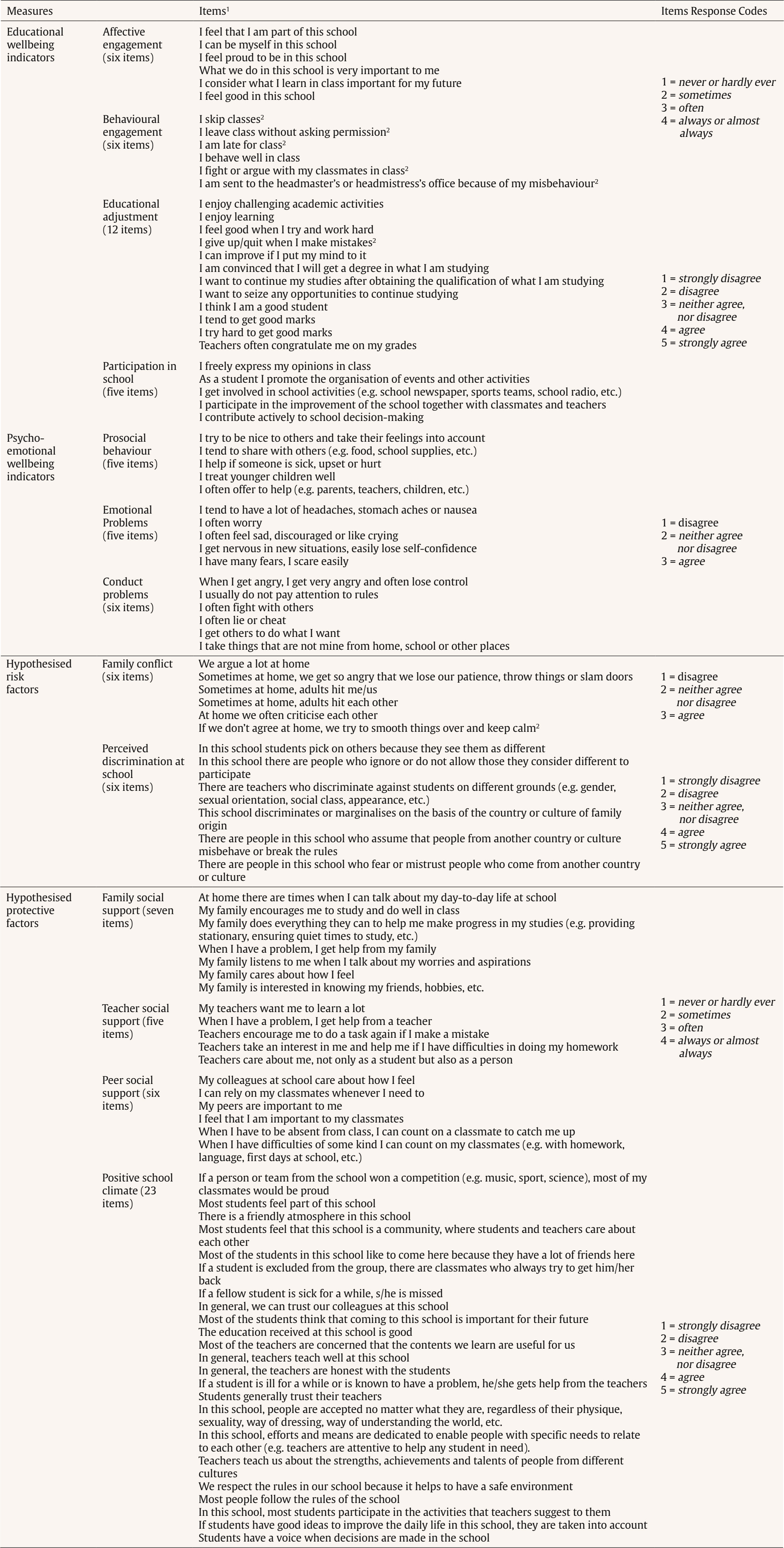 Note. 1Translated from the SURE project study questionnaire in Spanish to English; 2reversed coded. Statistical Analysis In the current study, LPA was used to identify the existence of distinct subgroups of adolescents based on observed patterns of responses to Likert scale indicators of wellbeing (Geiser, 2012). All analyses were conducted using the Mplus software (version 8), while the data set was prepared using the SPSS software (version 28). Prior to conducting the LPA, all wellbeing indicators were standardized to ensure that differences in the measurement scales did not influence the identification of the latent classes. To enhance the validity and replicability of the results, the study sample was randomly divided into two equal subsamples (Sinha et al., 2021). Once the LPA results were obtained from the first half of the sample, the analyses were replicated with the second half. This cross-validation procedure was not strictly applied in the sense of fixing the model parameters from the training sample and imposing them on the validation sample. Instead, the models were estimated independently in each subsample to examine the stability of the solutions. This approach helps mitigate the risk of overfitting, a common concern in exploratory models such as LPA, and provides additional confidence in the robustness of the identified latent profiles. Model selection was guided by several fit indices, including the relative fit indices Akaike Information Criterion (AIC), Bayesian Information Criterion (BIC), and Sample-Size Adjusted Bayesian Information Criterium (SABIC). In addition, entropy diagnostic criteria were used as an indication of the certainty of the estimate, with values above .70 being sufficient (Kassis et al., 2022; Lanza et al., 2013; Lanza & Cooper, 2016). Finally, comparative bootstrapped likelihood ratio tests were used to compare models with varying numbers of profiles. In particular we used Vuong-Lo-Mendell-Rubin Likelihood Ratio Test (VLMR) and the Lo-Mendell-Rubin Adjusted LRT Test. Preliminary results demonstrated a consistent decline in all fit indices with the inclusion of additional profiles. In cross-sectional LPA applications, this phenomenon can be attributed to the potential violation of the local independence assumption (Sinha et al., 2021). To assess local independence, Pearson correlations between the indicators were examined conditional on the class solution, resulting in the removal of one wellbeing indicator: problems with Peers. However, no further indicator was eliminated, as all other correlation coefficients were found to be lower than .40, suggesting that there were no severe issues of local dependence affecting the model fit (Sinha et al., 2021). Accordingly, profiles were identified using seven psychosocial wellbeing indicators (see Figure 1). To avoid local solutions, we increased the number of initial random starts to 100, with 20 final stage optimizations. No indications of convergence issues at local maxima were observed. Figure 1 Psychosocial Wellbeing Latent Profiles.  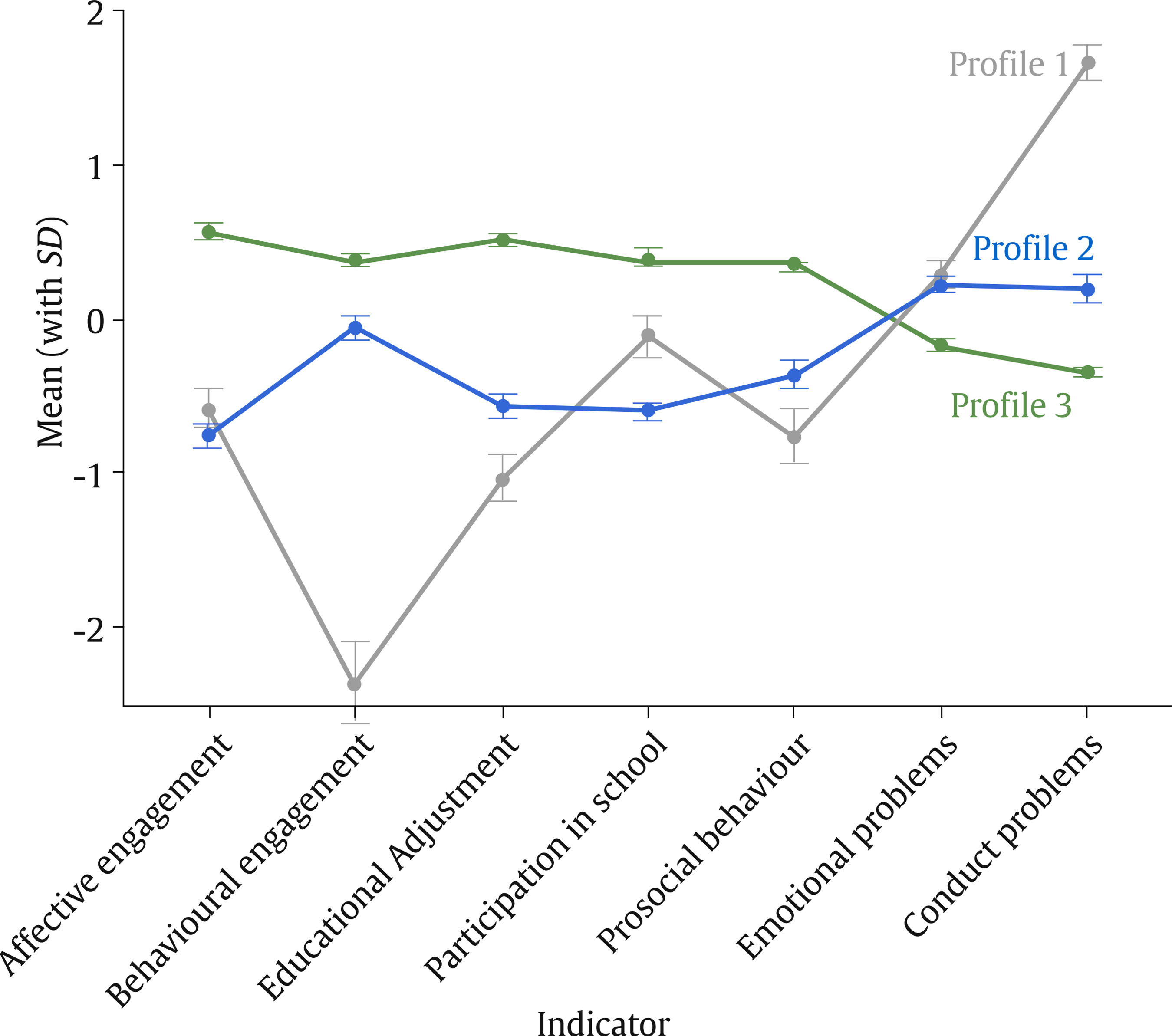 Note. Profile 1 = behaviourally challenging profile; Profile 2 = emotionally struggling profile; Profile 3 = psychoeducationally adjusting profile. Model selection was primarily guided by the Vuong-Lo-Mendell-Rubin (VLMR) test, which was the only index consistently supporting a three-class solution in the training sample, the total sample, and marginally in the validation sample. None of the other fit indices converged to an optimal solution in any of the samples. Although a four-class solution was also considered, its stability was assessed, and it was ultimately discarded. This decision was based on the observation that two of the resulting classes were a split of one of the three-class solution’s profiles, differing only in one of the seven indicators (prosocial behavior). This limited distinction suggested that these two classes lacked substantive validity. These findings led us to select the three-class solution, which was subsequently validated against external sociodemographic variables and risk and protective factors. The final LPA analysis with the whole sample (N = 1,627) is presented here due to space limitations. The results and model fit for the training and validation samples can be found in the Supplementary Material (Appendix A and B). Second, sociodemographic predictors (age, gender, migrant origin, and socioeconomic risk) were included in the model to identify factors associated with profile membership. This was done using multinomial logistic regression with the latent profiles as dependent variables using posterior probabilities (Múthen & Múthen, 2009). Finally, in a third step, the profile solution was also validated by examining theory-driven interpersonal predictors of profile membership (i.e., interpersonal risk and protective factors for psychosocial wellbeing). Out of the original sample of 1,627 adolescents, 41 cases were excluded from this regression model due to the presence of missing values in one or more predictors. Missing data represents only 2.4% of the total. Additionally, the χ2(2) = 4.166, p = .125 statistic showed that there was no association between missing data and profile membership. Model Selection LPA employs an iterative process to evaluate a series of discrete models, each delineating a distinct number of profiles. To determine the best profile solution, a combination of the best-fitting model and theoretically most meaningful profile solution was applied. Tables 2 and 3 present a summary of the model fit and diagnostic statistics for solutions with two to five profiles. As shown in Table 2, results demonstrated a consistent decline in all fit indices with the inclusion of additional profiles. The BLRT and LMR stopped being significant at a four-profile model, indicating that a four-profile solution was not superior to a three-profile solution. Moreover, the four-profile model exhibited a lower entropy value and yielded a profile solution with two redundant profiles with negligible differences in most wellbeing indicators. Thus, the three-profile solution was determined to be statistical and theoretically the most meaningful solution. Table 2 Model Fit Statistics for Class Solutions   Note. LL = log-likelihood; AIC = Akaike information criterion; BIC = Bayesian information criterion; SABIC = sample-size adjusted Bayesian information criterion. Table 3 Model Diagnostic Statistics   Note. ALCPP = average latent class posterior probabilities; VLMR = Vuong-Lo-Mendell-Rubin likelihood ratio test; LMR ALRT = Lo-Mendell-Rubin adjusted likelihood ratio test. *p < .05, **p < .01, ***p < .001. Interpretation of Psychosocial Wellbeing Latent Profiles Differences in Psychosocial Wellbeing Indicators Across Profiles The LPA results enabled the identification of three discrete profiles each including adolescents who exhibited similar patterns of psychosocial wellbeing (see Figure 1), showing statistical differences across profiles in all indicators (Tabla 4): Behaviourally Challenging Profile, Emotionally Struggling Profile, and Psychoeducationally Adjusting Profile. The profile of adolescents exhibiting the poorest outcomes (Behaviourally Challenging Profile) constituted the smallest proportion of the total sample, while Psychoeducationally Adjusting Profile, representing the opposite end of the spectrum and reflecting positive adjustment, constituted the largest group. Medium to large discrepancies in wellbeing were identified when the respective low-and high-level patterns of the identified profiles were compared. In order to facilitate a clear interpretation of which indicator values are above or below the sample means, z-standardised mean scale scores were employed (Spurk et al., 2020). Table 4 Comparison of Standardized Mean Psychosocial Wellbeing Scores by Profile Membership   Note. M = mean; SD = standard deviation. Different superscripts (1, 2, 3) indicate significant differences between profiles based on post hoc pairwise comparisons with Bonferroni correction (p < .05). Means that share the same superscript do not significantly differ from each other. *p < .05, **p < .01, ***p < .001. Adolescents in the Behaviourally Challenging Profile (8%) exhibited poor psychological and educational adjustment. In this profile, the prevalence of conduct problems was notably high, exceeding the sample mean. Furthermore, adolescents exhibited high levels of emotional distress and low levels of prosocial behaviour. As per their psycho-educational wellbeing, the levels of behavioural engagement and educational adjustment were markedly low, falling below the sample mean. Adolescents in the Emotionally Struggling Profile (35.6%) showed relatively high levels of psycho-emotional problems, exceeding the sample mean. Concurrently, they exhibited relatively low levels of educational wellbeing on the majority of educational indicators, falling below the sample mean. In particular, adolescents in the Emotionally Struggling Profile exhibited the lowest levels of affective engagement and participation in school, when compared to the other two profiles. Finally, adolescents in the Psychoeducationally Adjusting Profile constituting more than half of the sample (56.4%) showed good educational and psychological adjustment, with above-average scores on all indicators of educational wellbeing and prosocial behaviour, and below-average scores on behavioural and emotional problems. Differences in Sociodemographic Characteristics Across Profiles Before examining how interpersonal risk and protective factors predicted latent profile membership, we examined potential differences in socio-demographic characteristics among profiles to better conceptualise the latent profiles (Table 5). We found that profile membership varied by age (p = .026), family socioeconomic risk (p = .008), migrant background (p = .008), and school type (p < .001), but not by gender (p = .650). Nevertheless, the observed statistical differences were not substantial, as evidenced by the effect sizes, with the three profiles exhibiting similar sociodemographic characteristics. Sociodemographic Predictors of Psychosocial Wellbeing Multinomial logistic regression results showed a significant relationship between adolescents’ age, gender, migrant background, and family socioeconomic risk and membership of each of the psychosocial wellbeing profiles (see Table 6). Compared to boys, girls were less likely to be in the Behaviourally Challenging Profile than in Psychoeducationally Adjusting Profile. Although no significant differences by gender were observed in the descriptive comparison of profile membership (Table 5), these results suggest that gender becomes a significant predictor of profile membership when adjusting for other sociodemographic variables such as age, migrant background and socioeconomic risk. Non-binary adolescents, adolescents of migrant origin and adolescents living in more socioeconomically disadvantaged families were more likely to be in the Behaviourally Challenging Profile than in the Psychoeducationally Adjusting Profile compared to binary adolescents, native adolescents and adolescents living in less socioeconomically disadvantaged households. Results when comparing Behaviourally Challenging Profile with Emotionally Struggling Profile can be summarised as follows: older adolescents were less likely to be in Behaviourally Challenging Profile than in Emotionally Struggling Profile compared to younger adolescents, while adolescents living in more socioeconomically disadvantaged families were more likely to be in the Behaviourally Challenging Profile than in Emotionally Struggling Profile. Finally, results comparing the Emotionally Struggling Profile with the Psychoeducationally Adjusting Profile showed that only older age was a significant predictor of being in the Emotionally Struggling Profile, compared to younger age. Table 5 Sociodemographic Characteristics of Adolescents’ Wellbeing Profiles  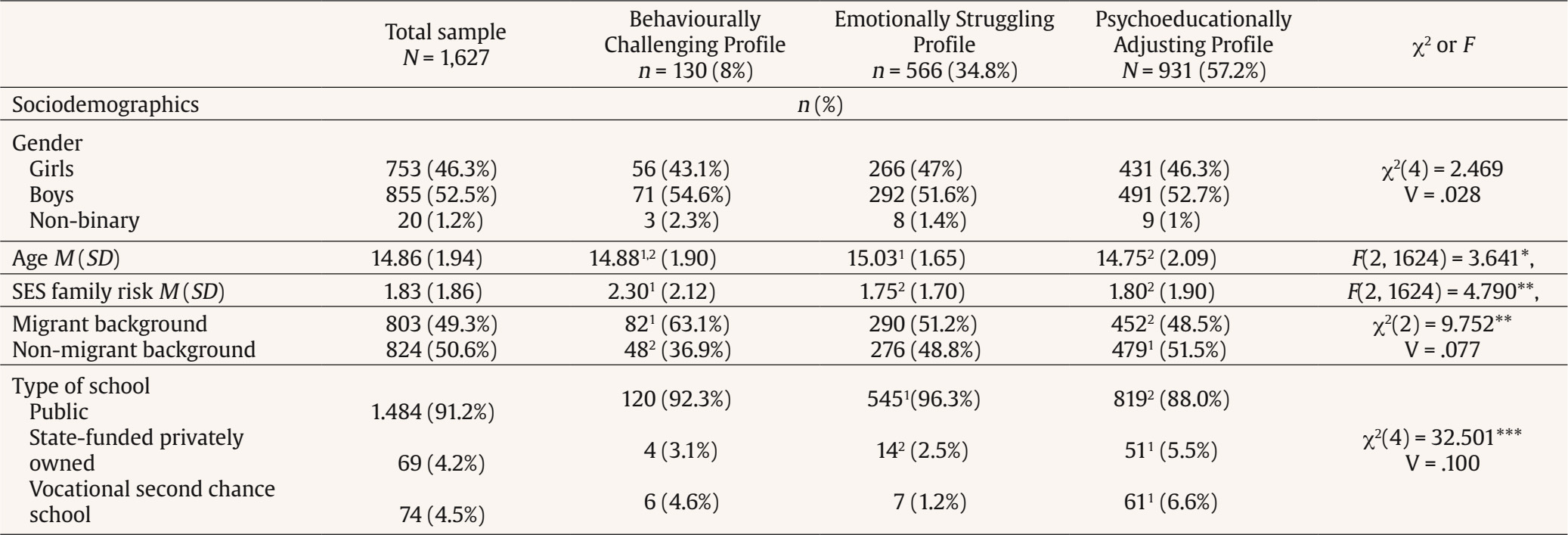 Note. χ2(df) = chi-square statistic for independence; F(df) = F statistic; V = Cramer’s V effect size; partial eta-squared. For quantitative outcomes SES and age different superscripts (1, 2, 3) indicate significant differences between profiles based on post hoc pairwise comparisons with Bonferroni correction (p < .05). Means that share the same superscript do not significantly differ from each other. For categorical variables Migrant and Type of School Superscripts indicate cells with standardized corrected residuals greater than |2| from the post hoc analysis of the chi-square test. Cells with higher-than-expected frequencies are marked with superscript 1, while those with lower-than-expected frequencies are marked with superscript 2 (p < .05). p < .05; **; p <.01; ***; p <.001. Table 6 Sociodemographic Predictors of Psychosocial Wellbeing  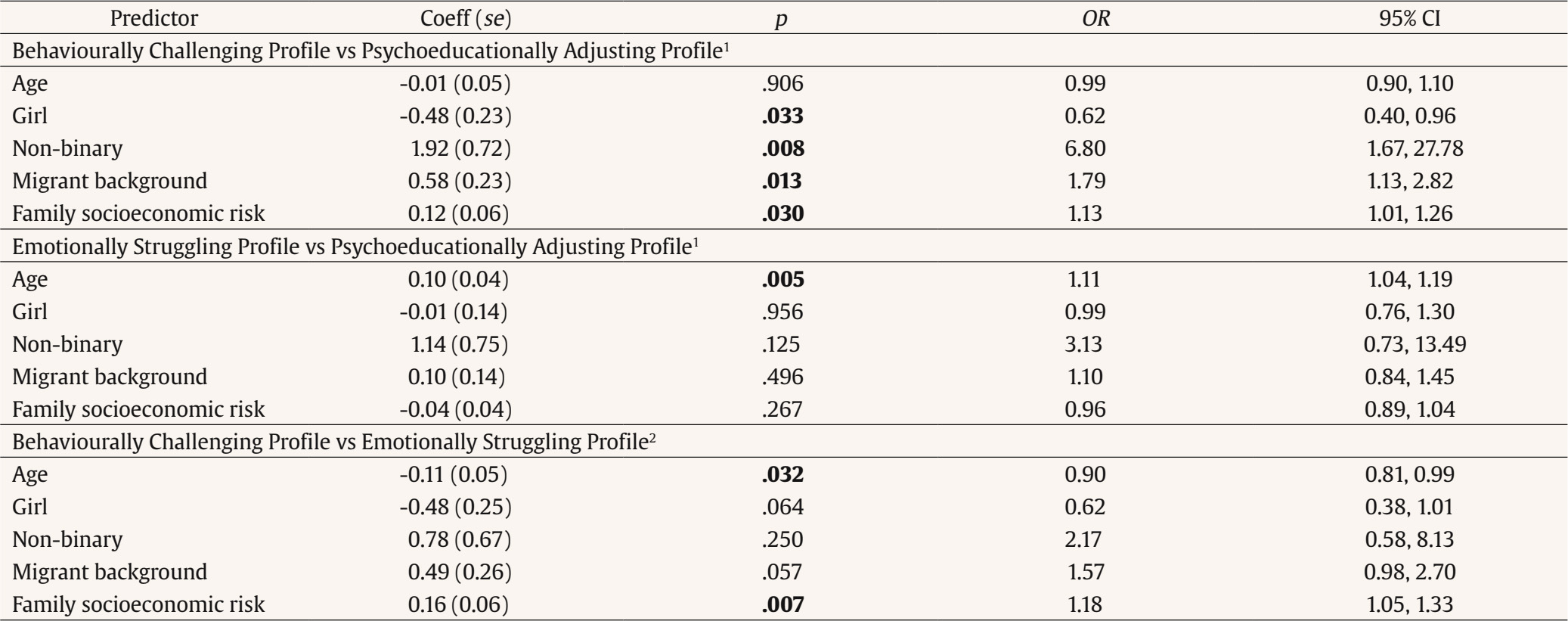 Note. N = 1,627; 1psychoeducationally adjusting profile is the reference category; 2emotionally struggling profile is the reference category; OR = odds ratio; Coeff = multinomial regression coefficient; SE = standard error; 95% CI = 95% confidence interval. Interpersonal Risk and Protective Factors for Psychosocial Wellbeing The results of the multinomial analysis demonstrated a statistically significant relationship between the majority of the investigated interpersonal factors and the membership of each of the identified psychosocial wellbeing profiles (see Table 7). A comparison of the two most extreme profiles (i.e., Behaviourally Challenging Profile and Psychoeducationally Adjusting Profile) revealed that all hypothesised interpersonal factors were significantly associated with profile membership. For example, adolescents who reported greater family conflict and perceived more discrimination at school were more likely to be in the Behaviourally Challenging Profile than in the Psychoeducationally Adjusting Profile, in comparison to adolescents who experienced less family conflict and perceived less discrimination at school. Conversely, adolescents with higher scores on perceived social support from family, teachers and peers, as well as those with more positive perceptions of school climate, were less likely to be in the Behaviourally Challenging Profile than in the Psychoeducationally Adjusting Profile, in comparison to those with lower scores in these areas. Table 7 Interpersonal predictors of psychosocial wellbeing.  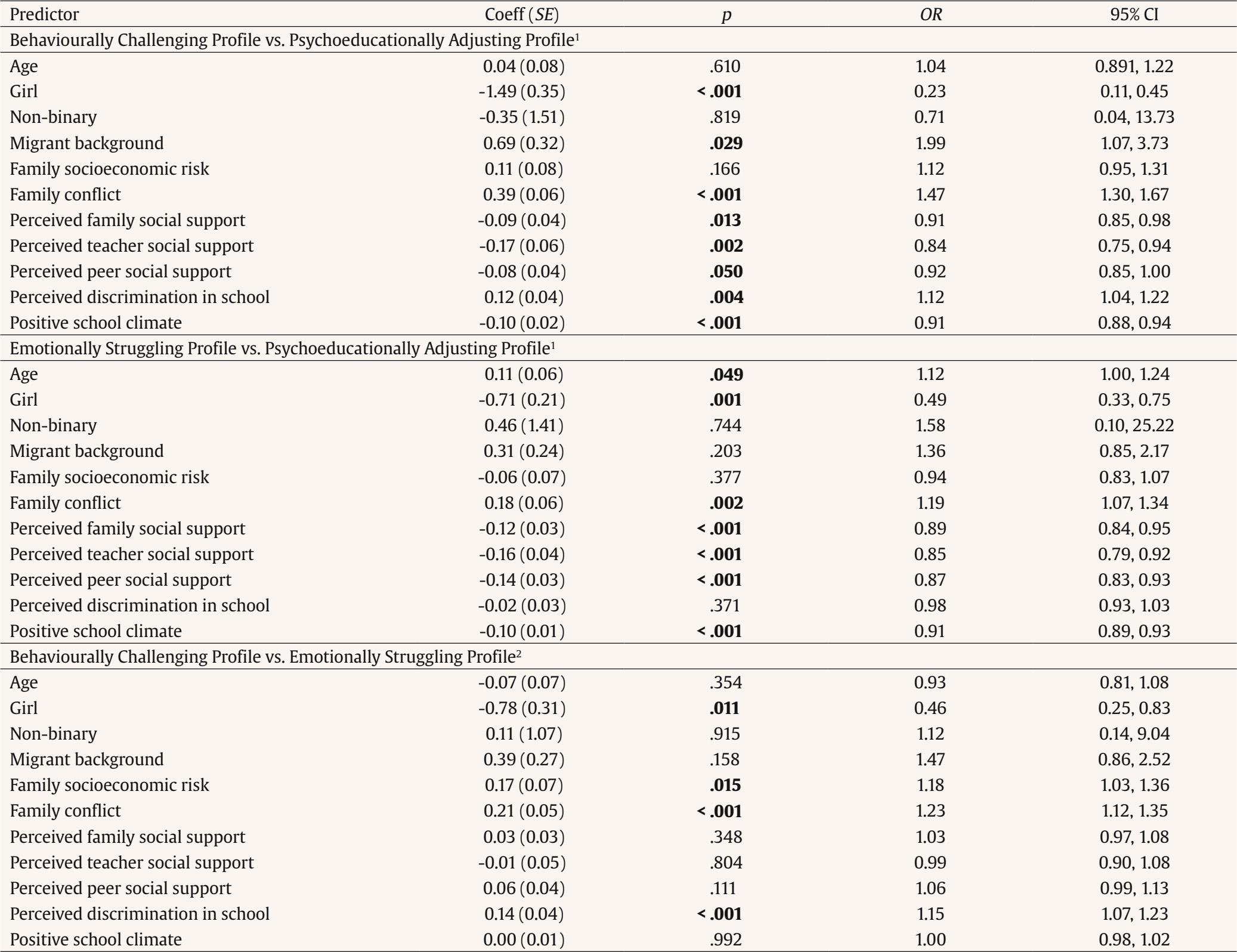 Note. N = 1,587. Results are from a multinomial logistic regression model predicting latent profile membership. Each predictor’s effect is reported as a regression coefficient (Coeff) with its standard error (SE), p-value, odds ratio (OR), and 95% confidence interval (CI). OR values greater than 1 indicate a higher likelihood of belonging to a given profile compared to the reference category, while values less than 1 indicate a lower likelihood. Reference categories: Psychoeducationally Adjusting Profile (for Behaviourally Challenging Profile vs. Psychoeducationally Adjusting Profile and Emotionally Struggling Profile vs. Psychoeducationally Adjusting Profile comparisons) and Emotionally Struggling Profile (for Behaviourally Challenging Profile vs. Emotionally Struggling Profile comparisons). Similar noteworthy results were observed when adolescents in the Emotionally Struggling Profile were compared to adolescents in Psychoeducationally Adjusting Profile who demonstrated good educational and psychological adjustment. However, perceived discrimination at school was not identified as a significant predictor of profile membership. Finally, when adolescents in the Behaviourally Challenging Profile with poor educational and psychological adjustment were compared with adolescents in the Emotionally Struggling Profile, similar patterns were observed for some of the variables. However, social support from any source was not identified as a significant predictor of profile membership. LPA Model and Identified Profiles This study contributes to the existing literature on adolescent wellbeing by integrating positive and negative indicators of psychosocial wellbeing across two domains (i.e., psycho-emotional and educational). This approach offers valuable insights into heterogeneity in adolescent wellbeing, even in a general population with no significant mental health concerns (Newlove-Delgado et al., 2022; Petersen et al., 2019). Our findings have important implications for prevention science: the concept of wellbeing is a multifaceted one, requiring the implementation of multicomponent interventions from a range of sectors, extending beyond the conventional focus of the health sector (Currie et al., 2012; Patton et al., 2016), especially in the case of developing individuals. The results of the LPA indicated the presence of distinct subgroups of adolescents: Behaviourally Challenging Profile, Emotionally Struggling Profile, and Psychoeducationally Adjusting Profile. Rather than identifying adolescent profiles made up of different combinations of wellbeing outcomes, our results suggest that adolescents tend to score well or poorly across domains, which seems to support developmental cascade models based on spillover effects across domains (Masten & Cicchetti, 2010). However, further longitudinal person-based models (i.e. latent transition analysis) are needed to confirm these effects. These models can be particularly helpful in informing more precise ‘theories of change’ for preventive interventions to better target key outcome mediators at key ages for different groups of adolescents (Cicchetti & Hinshaw, 2002). The Behaviourally Challenging group, characterised by maladjustment across various domains, constituted less than 10% of the total sample, a figure that aligns with global and Spanish literature documenting the prevalence of mental health problems in adolescents. This suggests that approximately 10-20% of adolescents experience serious mental health challenges (Hinton, 2019). The Psychoeducationally Adjusting Profile, representing more than 55% of all adolescents, appears to be particularly large in comparison to the very few person-based analyses in the literature that measure wellbeing outcome indicators among adolescents. These analyses may be indicating smaller groups of adolescents showing high psychosocial wellbeing. For instance, Kassis et al. (2022) identified a high wellbeing group representing between 30 and 36% of the total sample at two different time points. This discrepancy may be partially explained by the fact that the study measured subjective wellbeing in school context, in a sample of young adolescents aged 12 and 13 in Switzerland, within the context of COVID-19. Further research using similar indicators of psychosocial wellbeing is needed to compare psychosocial wellbeing profiles across age groups and countries. Risk and Protective Factors Important sociodemographic differences were found across the three psychosocial wellbeing profiles. For instance, migrant background was identified as the most significant socioeconomic predictor of poor psychological and educational adjustment, also when interpersonal risk and protective factors were included in the analysis. These results are aligned with the migration morbidity model hypothesis, in which migrant background youths may display poorer psychosocial adjustment compared to their non-migrant background peers (Guerra et al., 2019; Nauck & Genomi, 2019; Reed et al., 2018). Further examination of the characteristics of our participants confirmed that migrant adolescents in our sample were more likely to experience socioeconomic deprivation in their families than their native peers, which may account for some of the differences in wellbeing also observed in PISA education data (OECD, 2023). Our study contributes to this field of research by providing further insights into the experiences of migrant adolescents in secondary schools in Spain, particularly regarding educational and psychological wellbeing. Further longitudinal mixed-methods and qualitative research in the Spanish context is needed to gain deeper understanding of the different pathways and needs of students from a wide range of migrant backgrounds. These may include individuals from similar or different cultural and linguistic backgrounds; individuals who have been affected by conflict or forced migration and are undergoing asylum procedures; individuals arriving to Spain from abroad; individuals who were born in Spain to immigrant parents or arrived at a young age. This research should aim to identify specific malleable factors for each group that can be targeted by educational and psychosocial school-based interventions, as well as to prioritise at-risk subgroups of adolescents for special support. Furthermore, our findings contribute to the need for interventions that take into account intersectional theories, whereby membership of adolescent groups with low psychosocial wellbeing is influenced by combinations of membership of multiple social groups, such as migrant background, gender and low SES (Kern et al., 2020). Providing schools with adequate resources and support to implement school-level interventions to support diverse students with intersectional identities is increasingly emphasised in education policy (e.g., culturally responsive pedagogies, inclusive spaces and community engagement) (Varsik & Gorochovskij, 2023). As might be expected, adolescents with higher scores on perceived social support from family, teachers and peers, as well as those with more positive perceptions of school climate and less discrimination in school, were more likely to show positive adjustment than to be in worse profiles in terms of psychosocial wellbeing. These findings align with prior research conducted and suggest that perceived social support can serve as a protective factor, fostering resilience among the most disadvantaged youth (Luthar et al., 2000; Theron & Engelbrecht, 2012; Theron et al., 2014), which could be provided through school-family-community collaboration, taking into account the challenges of the context in which youth grow up (Bryan et al., 2020; Theron et al., 2014). The Role of Schools and Implications for Policy and Practice Overall, our findings confirm that the formation of healthy relationships with parents, teachers and peers facilitate the psychosocial development and wellbeing of adolescents. Results showed that positive school climate and perceived social support from peers, teachers and parents predicted adolescents to exhibit high psychosocial wellbeing levels. Therefore, the findings of this study support the notion that the ecological contexts in which adolescents live and socialise are key to meeting the developmental and psychosocial wellbeing needs of adolescents, (e.g. schools)(Bronfenbrenner & Morris, 2007), as well as connecting adolescents with elements of their context that maximise positive individual development (Tolan, 2014). The findings of our study contribute to the emerging evidence on the role of schools in supporting the psychosocial wellbeing of adolescents in secondary education (Choi, 2018; Viner et al., 2012; WHO, 2023). For instance, our results support the increasing evidence on the potential impact of schools fostering a positive school climate and strong peer-to-peer and teacher-to-student relationships in students’ lives (Patton et al., 2016). Both this empirical evidence as well as present school policies suggest that coordinated, multi-component, systemic, universal approaches can have important positive effects on the psychological wellbeing of students (Goldberg et al., 2019; Public Health England, 2023). These approaches apply a positive view of well-being and mental health, considers the wider social, environmental, and cultural needs and includes targeted early intervention and referral systems for those who need it (Weare, 2015). Despite the fact that the present study did not address individual-level factors beyond sociodemographic characteristics, it would be particularly valuable to consider the potential moderating and mediating effects of individual-level factors on the psychosocial wellbeing of adolescents, such as adolescents’ agency in making choices about relationships, goals, roles in settings and groups, and use of offered resources (Larson, 2000). This focus on adolescents’ agency and contribution is key to models of positive youth development that focus on variation in psychosocial wellbeing trajectories across different and diverse contexts, while avoiding consideration of group averages as the best indication of potential intervention effects (Tolan, 2014). In this sense, potential school-based interventions to promote adolescents’ psychosocial wellbeing and positive development can focus on improving the match between adolescents’ needs and capabilities and the supports and opportunities in their environment, e.g., promoting bonding, moral competence, prosocial behaviour (Tolan, 2014). Limitations It is important to consider the limitations of the current study. Firstly, it should be noted that the cross-sectional design does not allow for the inference of causality. Therefore, further evidence is required to establish whether the identified factors represent explanatory causal mechanisms for well-being (Small & Memmo, 2004). Secondly, although the sample size was sufficient to conduct LPA, the study comprised adolescents from diverse backgrounds and with different dates of arrival and lengths of residence in Spain. Prior research suggests that younger and older adolescents may be influenced by various risk and protective factors (Kim et al., 2015). Longitudinal studies of adolescents over a number of years could provide further insight into the changes that occur during this developmental period. It could also help to understand the cascading effects across developmental domains and inform timely promoting and preventive interventions for the psychosocial wellbeing of adolescents. Thirdly, despite the use of an ecological approach to the study of risk and protective factors in this study, other potentially important interpersonal factors from micro-, meso- and exosystems have not been considered. These include lack of community connections, interaction between families and schools, and social networks. For instance, the role of digital media and social networking in adolescents’ lives is becoming increasingly significant, both as a source of information and as a platform for social interaction. However, the potential harms of social networking and digital media use among adolescents are becoming increasingly evident (Patton et al., 2016), affecting adolescents’ self-esteem (Aucapiña & Campodónico, 2014) and leading to behavioural problems such as hyperactivity, insomnia or addictive behaviours (Arab & Díaz, 2015). Finally, it is important to consider the self-report nature of the instrument used to data-gathering and the need to exercise caution when generalising the findings, given that all adolescents in this study were attending secondary schools in the Madrid region. The use of multiple informants in research studies, including data from parents and teachers as well as adolescents, could reduce bias. Conclusions Our findings suggest that supportive relationships with parents, teachers and peers facilitate adolescents’ psychosocial development and well-being. Furthermore, our findings contribute to the growing body of evidence on the role of schools in supporting the psychosocial wellbeing of adolescents in secondary education, especially those who may be in a vulnerable situation due to different social characteristics, in order to guarantee their right to education and social inclusion. Conflict of Interest The authors of this article declare no conflict of interest. Acknowledgments We would like to extend our gratitude to Miruna Bivol, Nidhi Patel, Kappa Grealy, and Yi Chen for their invaluable contribution to the SURE project design and their active participation in data collection. Furthermore, we would like to express our profound gratitude to all adolescents, their families, teachers and schools for making this project a reality. Appendix Supplementary Material To identify a stable and generalizable latent profile solution, we implemented a cross-validation strategy based on a random split-sample approach. The full dataset (N = 1,628) was randomly divided into two equal subsamples. In the first subsample (training sample, n = 814), we performed a Latent Profile Analysis (LPA) to identify the optimal number of latent profiles based on a combination of fit indices and interpretability. In the second subsample (validation sample, n = 813), we conducted a second LPA using the same indicators to examine the replicability of the profile structure. For both the training and validation samples, we report model fit indices for solutions ranging from two to five profiles. These include the log-likelihood (LL), Akaike Information Criterion (AIC), Bayesian Information Criterion (BIC), Sample-Size Adjusted BIC (SABIC), Entropy, Average Latent Class Posterior Probabilities (ALCPP), the Vuong-Lo-Mendell-Rubin likelihood ratio test (VLMR), and the Lo-Mendell-Rubin adjusted likelihood ratio test (LMR ALRT). These analyses are intended as a form of cross-validation (albeit not strict cross-validation in a predictive sense), aimed at evaluating the stability of the latent profiles across independent subsamples. Appendix ALatent Profile Solution in Training Sample (n = 814) Table S1 Model fit statistics for latent profile solutions in the training sample (n = 814)   Note. LL = log-likelihood; AIC = Akaike information criterion; BIC = Bayesian information criterion; SABIC = sample-size adjusted Bayesian information criterion. Table S2 Appendix B Model Diagnostic Statistics for Latent Profile Solutions in the Training Sample (n = 814)   Note. ALCPP = average latent class posterior probabilities; VLMR = Vuong-Lo-Mendell-Rubin likelihood ratio test; LMR ALRT = Lo-Mendell-Rubin adjusted likelihood ratio test. † p < .10, *p < .05, **p < .01, ***p < .001. Latent profile solution in validation sample (n = 813) Table S3 Model Fit Statistics for Latent Profile Solutions in the Validation Sample (N = 813)   Note. LL = log-likelihood; AIC = Akaike information criterion; BIC = Bayesian information criterion; SABIC = sample-size adjusted Bayesian information criterion. Table S4 Model Diagnostic Statistics for Latent Profile Solutions in the Validation Sample (n = 813)   Note. ALCPP = average latent class posterior probabilities; VLMR = Vuong-Lo-Mendell-Rubin likelihood ratio test; LMR ALRT = Lo-Mendell-Rubin adjusted likelihood ratio test. † p < .10, *p < .05, **p < .01, ***p < .001. |
Cite this article as: Herrero Romero, R., van der Meulen, K., Granizo, L., del Barrio, C., Puyol, P., Lara, L., and Olmos, R. (2025). Interpersonal Risk and Protective Factors for Adolescents’ Psychosocial Wellbeing in Secondary Education: A Latent Profile Analysis. Psychosocial Intervention, 34(2), 117 - 135. https://doi.org/10.5093/pi2025a10
Correspondence: rocio.herrero@uam.es (R. Herrero Romero).Copyright © 2025. Colegio Oficial de la Psicología de Madrid


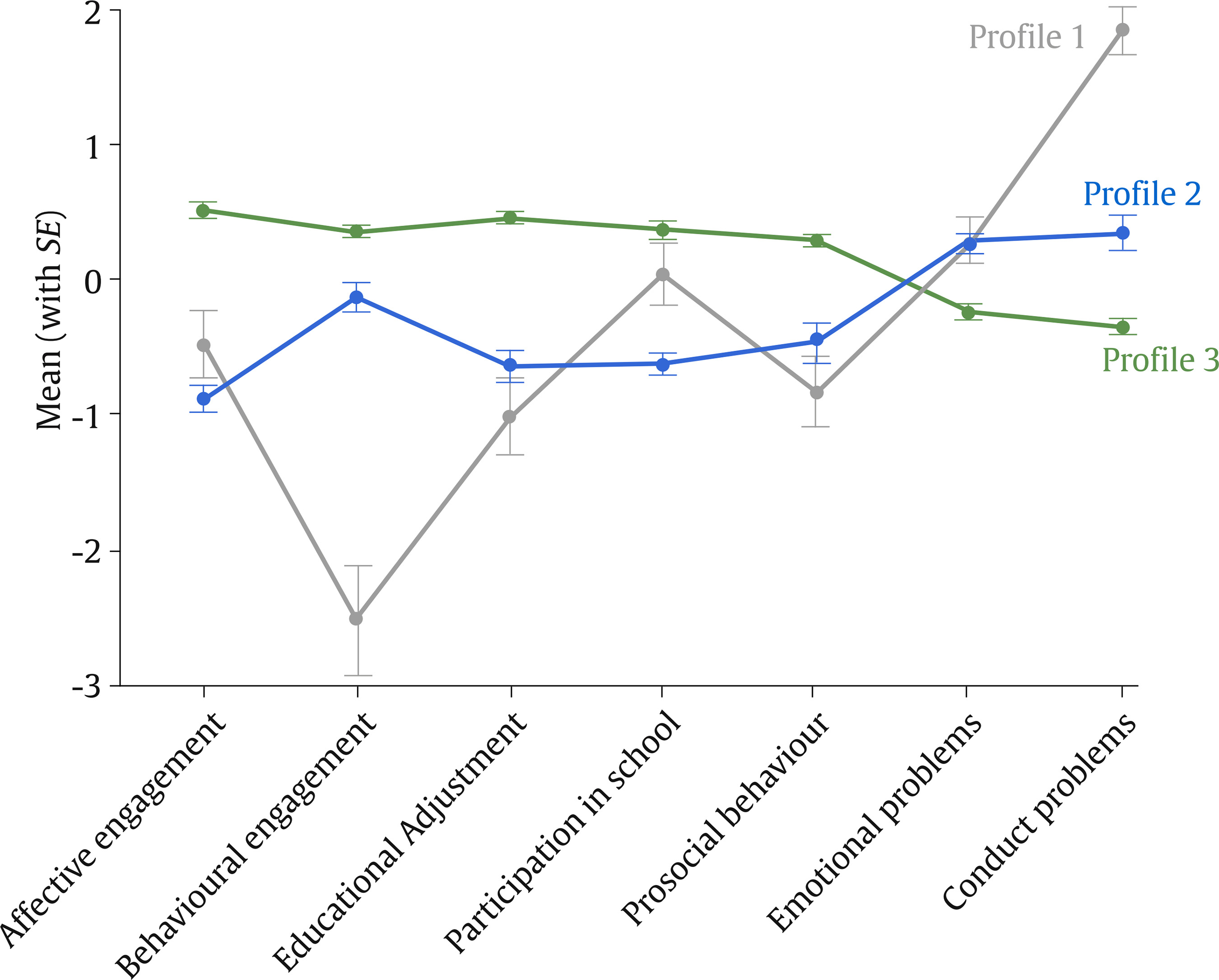
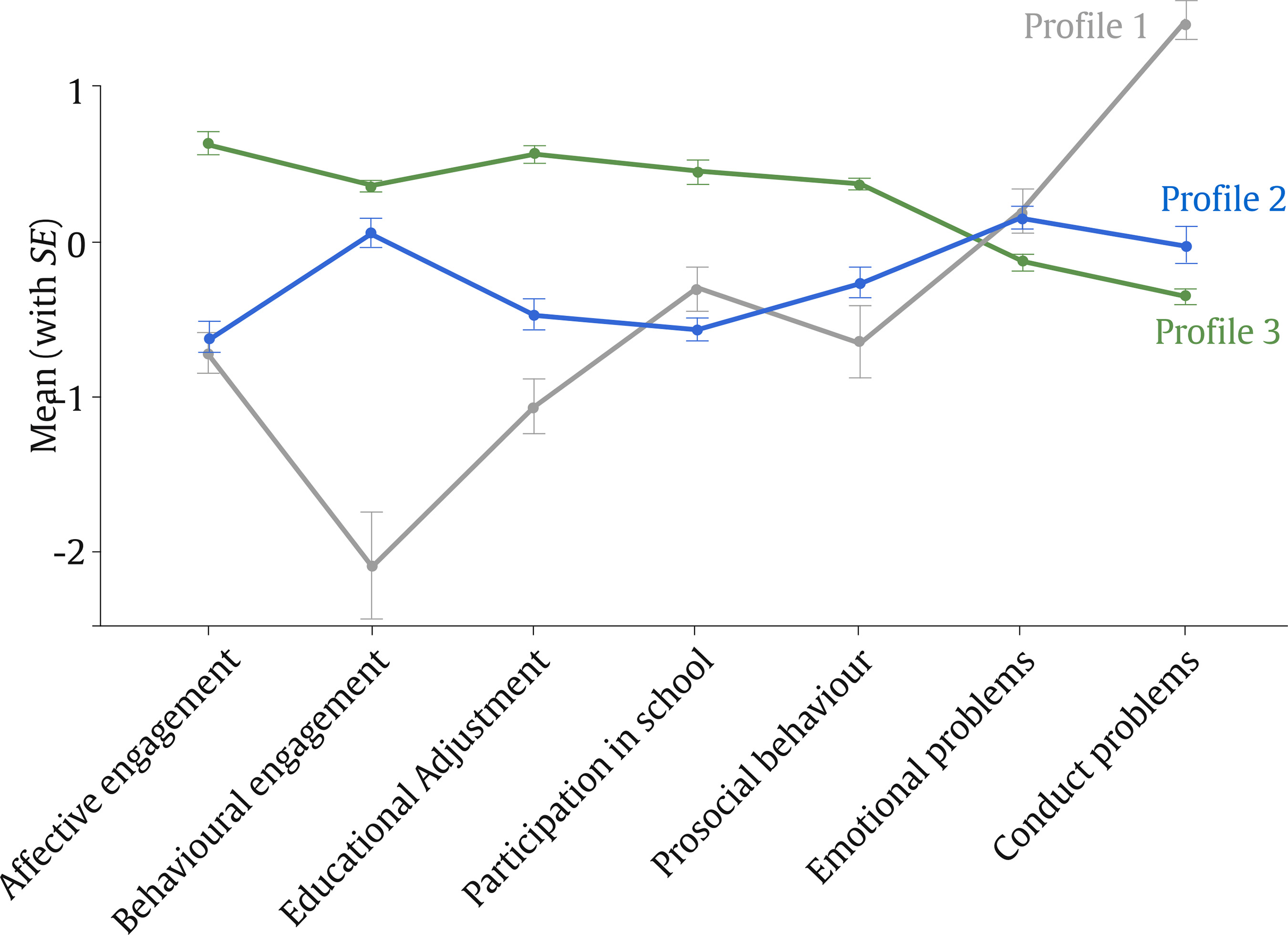






 e-PUB
e-PUB CrossRef
CrossRef JATS
JATS
